Influence of Positive and Negative Indian Ocean Dipoles on ENSO via the Indonesian Throughflow:Results from Sensitivity Experiments
ZHOU QianDUAN WansuoMU Muand FENG Rong
1State Key Laboratory of NumericalModeling for Atmospheric Sciences and Geophysical Fluid Dynamics, Institute of Atmospheric Physics,Chinese Academy of Sciences,Beijing100029
2University of Chinese Academy of Sciences,Beijing100049
3Key Laboratory of Ocean Circulation and Wave,Institute of Oceanology,Chinese Academy of Sciences,Qingdao266071
Influence of Positive and Negative Indian Ocean Dipoles on ENSO via the Indonesian Throughflow:Results from Sensitivity Experiments
ZHOU Qian1,2,DUAN Wansuo∗1,MU Mu3,and FENG Rong1
1State Key Laboratory of NumericalModeling for Atmospheric Sciences and Geophysical Fluid Dynamics, Institute of Atmospheric Physics,Chinese Academy of Sciences,Beijing100029
2University of Chinese Academy of Sciences,Beijing100049
3Key Laboratory of Ocean Circulation and Wave,Institute of Oceanology,Chinese Academy of Sciences,Qingdao266071
The role of the Indonesian Throughflow(ITF)in the influence of the Indian Ocean Dipole(IOD)on ENSO is investigated using version 2 of the Parallel Ocean Program(POP2)ocean general circulation model.We demonstrate the results through sensitivity experiments on both positive and negative IOD events from observations and coupled general circulation model simulations.By shutting down the atmospheric bridge while maintaining the tropical oceanic channel,the IOD forcing is shown to influence the ENSO eventin the follow ing year,and the role of the ITF is emphasized.During positive IOD events, negative sea surface height anomalies(SSHAs)occur in the eastern Indian Ocean,indicating the existence of upwelling. These upwelling anomaliespass through the Indonesian seasand enter the western tropicalPacific,resulting in cold anomalies there.These cold temperature anomalies furtherpropagate to the eastern equatorial Pacific,and ultimately induce a La Ni˜nalike mode in the follow ing year.In contrast,during negative IOD events,positive SSHAs are established in the eastern Indian Ocean,leading to downwelling anomalies thatcan also propagate into the subsurface of the western Pacific Ocean and travel further eastward.These downwelling anomalies induce negative ITF transport anomalies,and an El Ni˜no-like mode in the tropicaleastern Pacific Ocean thatpersists into the follow ing year.The effects ofnegative and positive IOD events on ENSO via the ITF are symmetric.Finally,we also estimate the contribution of IOD forcing in explaining the Pacific variability associated w ith ENSO via ITF.
IOD,Pacific Ocean,ENSO,Indonesian Throughflow
1.Introduction
The El Ni˜no-Southern Oscillation(ENSO)is the most importantair–sea interaction phenomenon in the tropical Pacific.The occurrence of ENSO causes extreme weather and climate events across the globe,leading to severe naturaldisasters(Wang etal.,2000;Diaz etal.,2001;Alexanderetal., 2002).Consequently,it is of great importance to study the dynam ics of ENSO to predict events successfully(Latif et al.,1998;Chen etal.,2004;Jin etal.,2008;Luo etal.,2008; Tippettetal.,2011).
The Indian Ocean Dipole(IOD)is an air–sea coupled phenomenon.Some studies argue that the IOD is dependenton Pacific Ocean air–sea interactions(Allan etal.,2001; Nicholls et al.,2001;Baquero-Bernal et al.,2002;Lau and Nath,2003),while others claim it is an intrinsic physical entity,independentof ENSO(Sajiand Yamagata,2003;Behera etal.,2006;Luo etal.,2010).Eitherway,the IOD can be influenced by ENSO events(Nagura and Konda,2007;Schott etal.,2009;Luo etal.,2010;Roxy etal.,2011).
It has been suggested that ENSO prediction by both statistical(Clarke and Van Gorder,2003;Izumo et al.,2010; Izumo etal.,2014)and dynamicalmodels(Luo etal.,2010) is improved by including Indian Ocean information.Forexample,Izumo et al.(2010)predicted the ENSO peak during 1981–2009 w ith a lead time of 14 months by adopting the corresponding borealautumn Dipole Mode Index(DM I) and warm water volume(WWV)as predictors.They also extended this conclusion to ENSO forecasting during 1872–2008(Izumo etal.,2014),and revealed that the DM Iis much more helpful in improving ENSO hindcast skill compared w ith an Indian Ocean basin-w ide mode,the Indian Monsoon,or the ENSO index itself.These results imply that the IOD may significantly influence ENSO predictability.Furthermore,the atmospheric bridge is suggested to be a lead-ing contributor to the influence of IOD on ENSO(Alexander etal.,2002;Annamalaiet al.,2005;Kug and Kang,2006). Gear-like coupling between the Indian and Pacific oceans (GIP)is anothermechanism proposed to interpretthe interactions between the tropical Indian and Pacific Ocean climate systems(Wu and Meng,1998).Sensitivity experiments have shown that,through GIP,the air–sea interaction in one ocean basin forced by zonal w ind stress anomalies can cause air–sea interaction in the otherocean,resulting in anomalous SST (Meng and Wu,2000).
By calculating observed time series lag correlations,Yuan etal.(2013)recently suggested that the influence of the IOD on ENSO may occur via the Indonesian Throughflow(ITF), the only ocean channel between the tropical Indian and Pacific oceans.Earlier,they had also conducted GCM sensitivity experiments w ith a closed atmospheric bridge which,togetherw ith the observational results,confi rmed theirhypothesis(Yuan etal.,2011).The results suggest that it is the ITF that can convey the IOD event forcing into the tropical Pacific Ocean in the follow ing year.However,itis worth noting that Yuan etal.(2011)only studied the influence of one IOD event(in 1997)on the follow ing year’s Pacific Ocean air–sea coupled system,and did so using the LASG(State Key Laboratory of Numerical Modeling for Atmospheric Sciences and Geophysical Fluid Dynam ics)IAP(Institute of Atmospheric Physics)Climate Ocean Model(LICOM)and a coupled model.Moreover,the 1997 IOD eventwas an extreme positive event.In thispaper,we ask ifanotherocean model—version 2 of the Parallel Ocean Program(POP2)ocean general circulation model(OGCM)—shows sim ilar connections between positive IOD events and subsequent La Ni˜na-like states.Like ENSO events,IOD events also possess significantasymmetry(Hong etal.,2008a;2008b).Therefore,we also question how a negative IOD event influences ENSO in the Pacific Ocean:Is it opposite to that of a positive IOD? A lso,to what extent does the IOD forcing contribute to the Pacific variability associated w ith ENSO?These questions are addressed in the presentstudy.
The remainderof this paper is organized as follows.Section 2 describes the model and data used in this study.The experimental strategy is introduced in section 3.The role of the ITF in conveying IOD forcing to the Pacific Ocean is investigated in section 4.The contribution of IOD forcing to the Pacific variability associated w ith ENSO via the ITF is estimated in section 5,followed by a summary and discussion in section 6.
2.M odeland data

Fig.1.Simulation of ENSO and IOD in the CESM 1.0.3 control run(year0051–0150).Powerspectrum of(a)the Ni˜no3 index and(b)Dipole Mode Index(DM I).(c)Fourteen positive/negative IOD events from the coupled model(dashed lines)(mean shown in bold).(d)Monthly mean climatological ITF transportvolume.
The POP2 OGCM(Danabasoglu etal.,2011),originally developed at the Los Alamos National Laboratory,butw ith more recentwork on parameterizations largely added by theNational Center for Atmospheric Research,is used in this study.It is az-level hydrostatic primitive equation model w ith 60 levels.The vertical spacing is 10 m at the surface and varies w ith depth.The nom inal horizontal resolution is 1◦×1◦in the off-equatorialarea w ith an enhanced resolution of(1/3)◦latitude by 1◦longitude in the tropics.
The observationaldata used are from version 2 of the Coordinated Ocean Research Experiments(COREv2),w ith a horizontal resolution of 1.9◦(lat)× 1.875◦(lon).The relevant variables include:the atmospheric forcing of precipitation;airabsolute humidity;sea levelpressure;air temperature;w ind speed;and longwave downward,shortwave downward,and shortwave upward radiation.All these forcing data are from the Geophysical Fluid Dynam ics Laboratory (GFDL)website(http://data1.gfdl.noaa.gov/nomads/forms/ mom4/COREv2.htm l).Observational sea surface height (SSH)from the TOPEX/Poseidon satellite mission is also used.
Due to the shorthistory of observational records,we additionally use forcing data extracted from a coupled general circulation model’s long-term run.Since version 1.0.3 of the Community Earth System Model(CESM 1.0.3)(which uses POP2 as its ocean component)simulates both the ENSO (Deser et al.,2012)and IOD well,and provides an acceptable simulation of the ITF(Large and Danabasoglu,2006; Jochum et al.,2009),we adopt the output of this coupled model to validate the results obtained from the observation. CESM 1.0.3 has been integrated for 150 years,and the fi rst fi fty years(0001–0050)of the coupled run are discarded due to the initial adjustment of the model.The simulated ENSO in the coupled modelhasa period of3–6 years(Fig.1a),w ith a reasonable amplitude and latitudinal w idth of the anomalous equatorial zonal w ind stress.El Ni˜no events modeled by CESM 1.0.3,like observed ENSO events,also peak at the end of the calendar year.The simulated IOD has a period of 1–2 years(Fig.1b),usually peaking in boreal autumn and decaying in boreal w inter(Fig.1c),and roughly captures the features of observed IOD events.Because the 6◦S section goes through three major channels—the Lombok Strait, the Ombai Strait,and the Timor Sea—the ITF in this studyis defined as the flow across the 6◦S section from 115◦E to 130◦E in the upper700 m of the Indonesian seas.The simulated monthly mean climatology of the ITF transportvolume (Fig.1d)also has a signifi cant seasonal signal,which peaks in summerand decays in w inter.This feature is in accordance w ith other OGCM simulation products(Lee etal.,2010)and observations(Wyrtki,1987;Meyers etal.,1995;Shinoda et al.,2012).Based on this analysis,we accept that the simulated ENSO,IOD and ITF are suitable for investigating the role of the ITF in connecting the Indian and Pacific oceans.
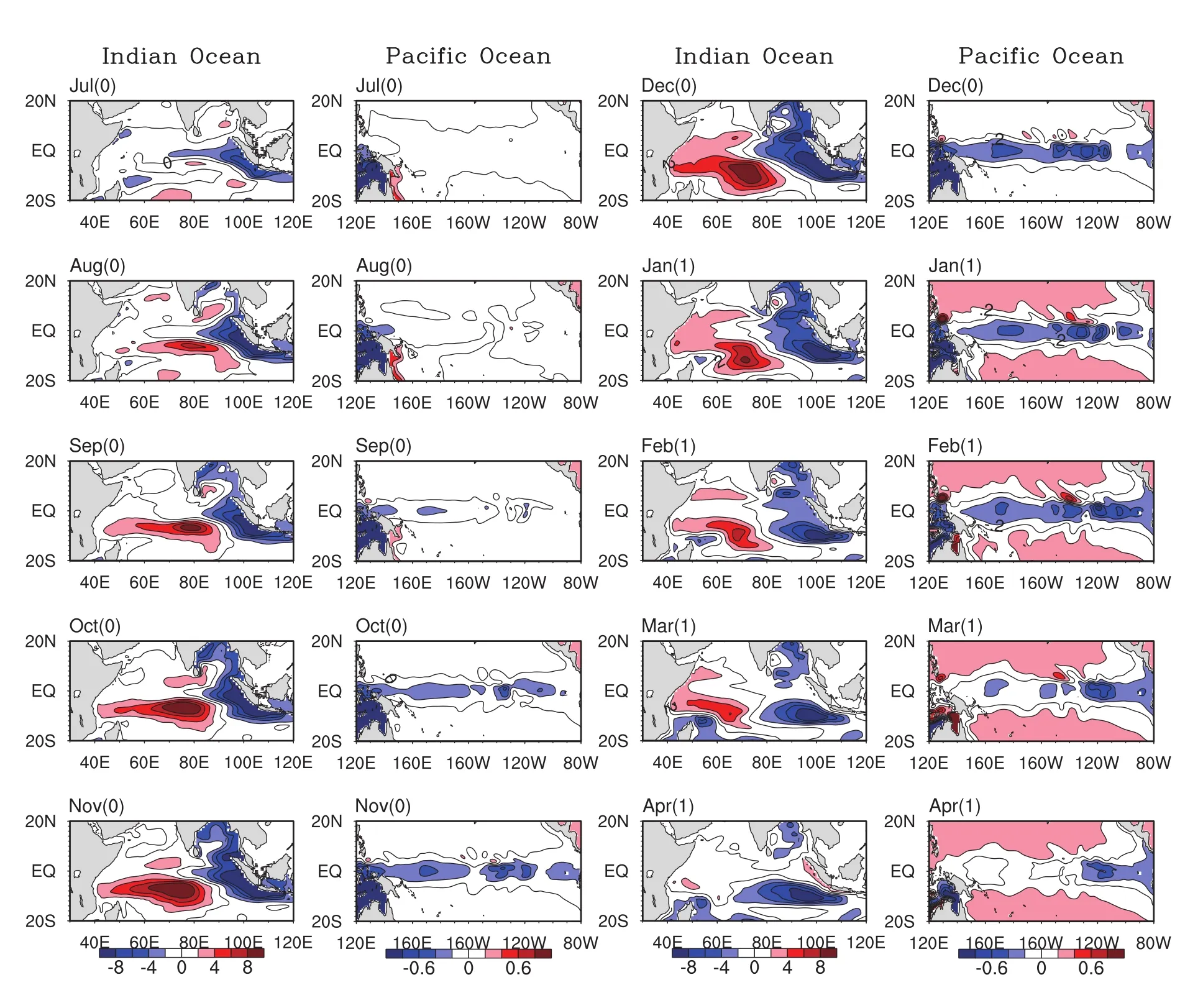
Fig.2.OGCM-simulated SSHAs between sensitivity runs forced by atmospheric forcing from observed positive IOD events and a control run during Jul(0)to Apr(1)over the Indian Ocean(contour interval:2 cm)and Pacific Ocean(contour interval: 0.2 cm).
3.Design of the sensitivity experiments
We use the POP2 OGCM to conduct numerical experiments.The model is fi rstintegrated w ith climatological forcing for 60 years,referred to hereafter as the“control run”. Then,sensitivity experiments are conducted at the end of year 57 to replace the Indian Ocean forcing w ith the daily w ind stress and heat flux ofan IOD year.The differences between the sensitivity experiments and the OGCM control run thus represent the interannual variations of the Indian Ocean circulation forced by the IOD w ind and heat flux anomalies in a non-coupled configuration,i.e.the IOD forcing influences on the Pacific Ocean through the Indonesian passages. In this study,we focus on the differences between the sensitivity experiments and the OGCM control run to explore the role played by the ITF during both positive and negative IOD events in influencing Pacific SST associated with ENSO.For simplicity,we use the term“anomalies”to denote these differences.
For the observational run,the mean atmospheric state(see section 2)during 1970–2000 is used as the climatological forcing.The daily atmospheric forcing associated w ith the positive IOD years of1982,1983,1991,1994 and 2006,and the negative IOD years of 1975,1980,1981,1989 and 1992, are used.For the model data,atmospheric data of 14 positive IOD events and 14 negative IOD events from the coupled long-term run of CESM 1.0.3(shown in Fig.1c)and the mean of 100 years of the control run are used as daily and climatological forcing,respectively.
4.Role of the ITF in conveying the IOD forcing on the Pacific Ocean
First,we compare the POP2 simulations to those of Yuan etal.(2011)in describing the role of the ITF during the 1997 positive IOD event.The sensitivity experiments associated w ith the 1997 positive IOD event show that it can induce a La Ni˜na-like mode in the follow ing yearvia the ITF,in good agreementw ith the results of Yuan etal.(2011)(for brevity, the details are om itted here).Having established this good agreement,we proceed to simulate the role of the ITF in conveying the positive IOD impact on the Pacific SST by conducting more sensitivity experiments w ith IOD forcing using POP2.In particular,we investigate the role of the ITF in conveying the negative IOD’s forcing on Pacifi c SST.
4.1.Role of the ITF in conveying the positive IOD forcing on the Pacifi c Ocean
4.1.1.Sensitivity experiments forced by the observed atmosphere during positive IOD events
First,we use the observed climatological atmospheric state to force the POP2 model,producing a control run.Second,two-year sensitivity experiments are performed using the observed daily heat flux and w ind observations from positive IOD years(1982,1983,1991,1994 and 2006)and their follow ing years as the external forcing over the Indian Ocean, whilst at the same time retaining the climatological atmospheric forcing over other ocean basins.The differences between the sensitivity experiments and the control run are obtained as the so-called anomalies,including SSH anomalies (SSHAs)and sea surface temperature anomalies(SSTAs),to identify the role of the ITF in the IOD’s influence on the Pacific SST associated w ith ENSO.

Fig.3.The ITF anomaly for(a)volume transport and(b) heat flux transportdifferences between sensitivity experiments of observed positive IOD events and the OGCM control run (dashed lines).Solid bold lines represent the mean.
Figure 2 displays the composite SSH anomalies of the observed positive IOD forcing periods over the Indian Ocean and the Indo-Pacific regions from Jul(0)to Apr(1)(“0”and“1”denote the IOD year and the subsequent year,respectively).Positive IODs occurw ith positive SSHAs in the western Indian Ocean,and negative SSHAs in the east;the nega-tive SSHAs in the eastern Indian Ocean indicate a shoaled thermocline and upwelling currents.The upwelling anomalies are amplified and transported into the Pacific Ocean in Aug(0),and persist in the equatorial Pacific Ocean into the follow ing year.The SSHAs indicate that the differences between the sensitivity experiments and the control run arise from the shutting down of the atmospheric bridge while the ITF remains.The resulting propagation of negative SSHAs from the Indian Ocean to the Pacific Ocean demonstrates the role of the ITF in connecting the Indian Ocean and Pacific Ocean interannualanomalies.
The anomalies of ITF volume and heat transport along 6◦S are shown in Fig.3.If the ITF anomalies are positive (negative),it means that the warm pool loses(gains)more heatand WWV to(from)the Indian Ocean,implying a propagation of the cold(warm)temperature anomalies from the Indian Ocean to Pacific Ocean.During positive IOD event years,the ITF anomalies become positive in Aug(0),peak in Dec(0),decay over the w inter and reverse to negative in Mar(1).Positive ITF transport anomalies lead to cold sea temperature anomalies in the eastern Indian Ocean to Pacific Ocean,thus inducing a La Ni˜na-like state in the Pacific Ocean.
Figure 4 plots the subsurface temperature anomalies in the equatorialverticalsection of the Pacific Ocean.Itclearly shows that cold subsurface sea temperature anomalies fi rst appear in the western Pacific in Aug(0),as a result of ITF anomalies.These cold anomalies then propagate into the eastern Pacific,maintaining a La Ni˜na-like cooling state until the follow ing year.The propagation of these cold subsurface temperature anomalies also suggests a role of the ITF during positive IOD forcing,leading to an influence on the follow ing year’s La Ni˜na events in the Pacific Ocean.
4.1.2.Sensitivity experiments forced by CESM 1.0.3 atmospheric forcing during positive IOD events
The observational record associated w ith IOD events has a short history.Therefore,to further validate the results in section 4.1.1,we use the outputs of the coupled model, CESM 1.0.3,to repeat the experiments.A totalof14 positive IOD events(see Fig.1c)are selected,based on the 100-year time series of SSTAs in the coupled modeloutputs,and from which the atmospheric forcing fields are extracted.A ll the sensitivity experiments are completed using the same experimental strategy described in section 4.1.1,except that the climatologicaland positive IOD atmospheric forcing are extracted from the 100-year time series of the long-term run of CESM 1.0.3.
Sim ilar to the results shown in section 4.1.1,negative SSHAs are established in the eastern Indian Ocean in summer,indicating an anomalous upwelling that induces cold temperature anomalies. These upwelling anomalies and SSHAs propagate through the Indonesian seas,giving rise to cold temperature anomalies in the subsurface layer of the tropicalwestern Pacifi c(Fig.5).These cold anomalies propagate to the tropical eastern Pacific,where they ultimately dom inate and result in a La Ni˜na-like mode in the following year.The cold anomalies in the eastern Pacific Ocean are much weaker than those from the sensitivity experiments using the observed positive IOD forcing.These differences may result from the deficiencies of the coupled modelin simulating the IOD strength.

Fig.4.Composite OGCM-simulated sea temperature anomalies(units:◦C)in the equatorial vertical section of the Pacific Ocean between sensitivity experiments forced by observed positive IOD events and the control run during Feb(0)to Jun(1).

Fig.5.As in Fig.4,but for composite temperature anomalies from sensitivity experiments on the 14 positive IOD events from the CESM 1.0.3 long-term run.
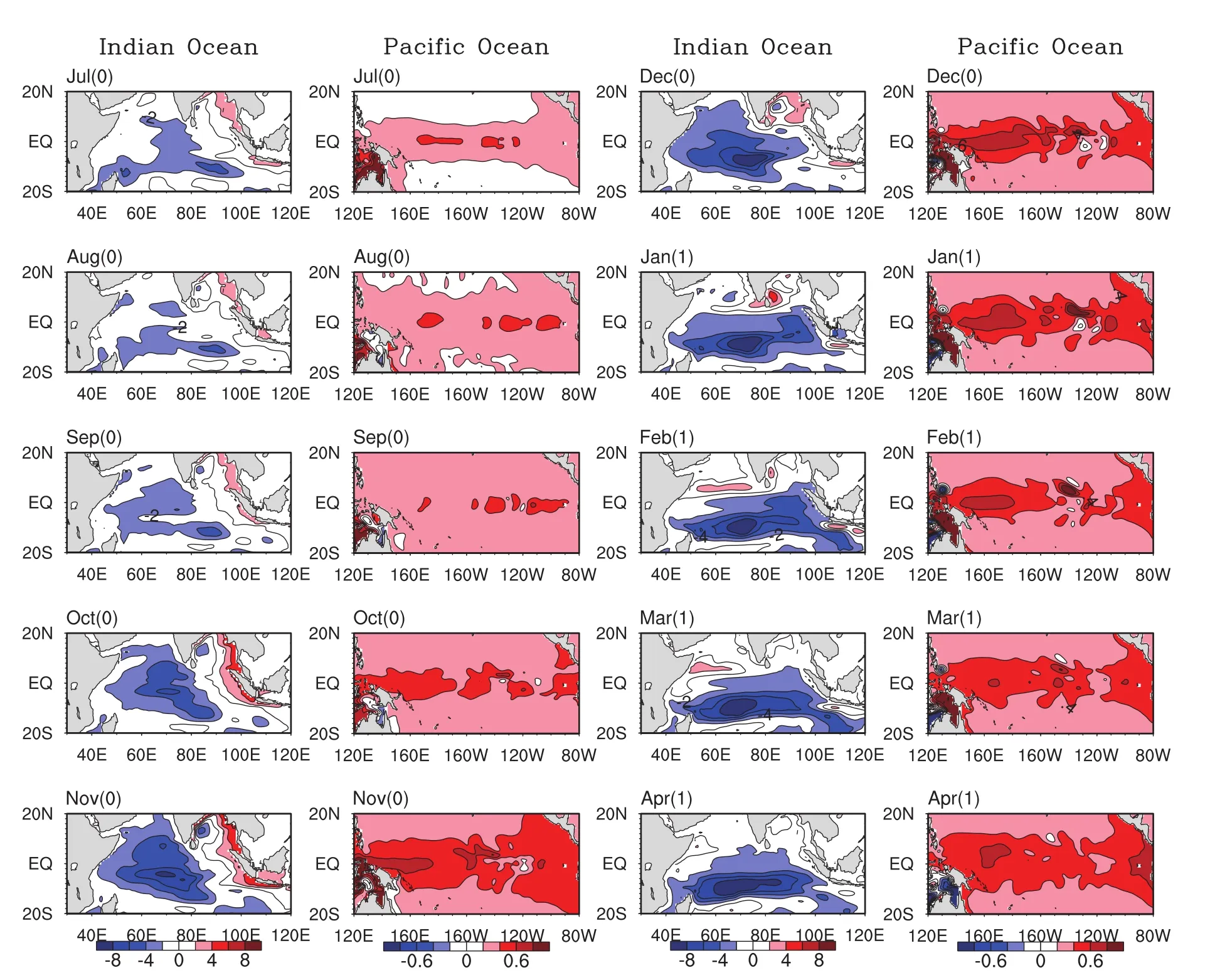
Fig.6.As in Fig.2,but for composite SSHAs from sensitivity experiments on negative observed IOD events.
These results demonstrate that,asin the observation,positive IOD events modeled by CESM 1.0.3 can influence thestate of the Pacific Ocean in the follow ing year through the tropicalocean channel.This suggests that the role of the ITF in conveying the positive IOD impacton the follow ing year’s ENSO is robust.
4.2.Role of the ITF in the infl uence of negative IOD on Pacifi c SST
As demonstrated in section 4.1,a positive IOD event may induce negative SSHAs in the eastern Indian Ocean. Upwelling anomalies associated w ith these negative SSHAs propagate across the ITF passages and spread eastward,inducing cold anomaliesin the eastern Pacific Ocean and forming La Ni˜na-like SST anomalies in the follow ing year.In this section,we investigate the role of the ITF during negative IOD events in influencing the Pacific SST.
Forobserved negative IOD events,the design of the sensitivity experimentis the same as thatin section 4.1.1,except that the atmospheric forcing in negative IOD years(1975, 1980,1981,1989 and 1992)is used as the forcing factor in the experiments.Figure 6 plots the composite SSHAs corresponding to the observed negative IOD events from Jul(0) to Apr(1)over the Indian Ocean and Pacific region.The negative SSHAs in the western Indian Ocean,and the positive anomalies in the east,indicate the existence of a negative IOD.The positive SSHAs in the eastern Indian Ocean suggestan enhancementof the thermocline depth and downwelling signals.These SSHAs and downwelling anomalies get stronger in the follow ing months,propagating into the western Pacific Ocean.The propagation of the positive SSHAs into the Pacific Ocean must take place through the Indonesian seas because the atmospheric bridge is closed in these sensitivity experiments.
The ITF volume and heat flux transportanomalies shown in Fig.7 furtherdemonstrate the role of the ITF.The negative ITF anomalies during negative IOD events appear in Aug(0), peak in Dec(0),and reverse sign in Mar(1).The negative ITF transportanomalies prove that the downwelling anomalies in the eastern Indian Ocean propagate from the Indian Ocean to the western Pacific Ocean.These downwelling anomalies further induce an El Ni˜no-like state in the Pacific Ocean, which can be traced from the sea temperature anomalies in the vertical section of the equatorial Pacific Ocean(see Fig. 8).This shows that in the tropical Pacific Ocean,warm subsurface sea temperature anomaliesappear in the western part, as a resultof ITF transportanomalies.These warm anomalies then propagate to the eastern Pacific,maintaining an El Ni˜no-like warm ing state through to the nextyear.
Similar to the analysisofpositive IOD events,furthersensitivity experiments are conducted to examine the role of the ITF in the influence of negative IOD on the Pacific Ocean (Fig.9),but w ith the atmospheric forcing provided by 14 negative IOD events from the CESM 1.0.3 coupled long-term run(Fig.1c).The results correlate closely w ith the observed atmospheric forcing.Therefore,we conclude that negative IOD events can influence ENSO via the ITF,leading to an El Ni˜no-like state in the tropical Pacific Ocean in the follow ing year.
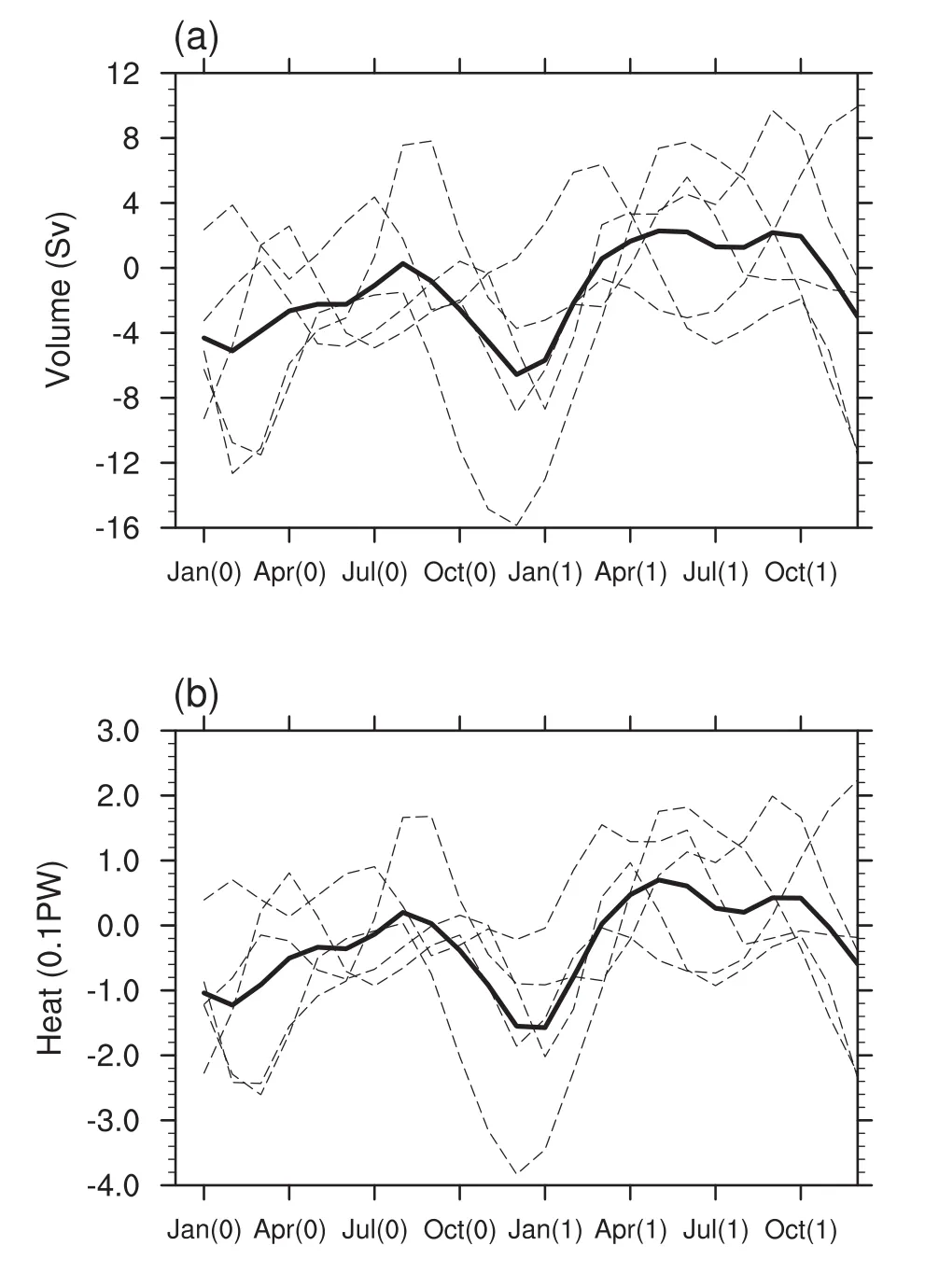
Fig.7.As in Fig.3,but for the ITF anomalies from sensitivity experiments on negative observed IOD events.
5.Estimation of the contribution of IOD forcing to the Pacific variability associated w ith ENSO
In this study,the role of the ITF in the influence of both positive and negative IOD forcing on ENSO is explored.Specifically,positive IOD forcing in the tropical Indian Ocean can resultin negative SSHAsin the eastern Indian Ocean.These negative SSHAs pass through the Indonesian seas and lead to a La Ni˜na-like state in the eastern Pacific Ocean the follow ing year.For negative IOD forcing,positive SSHAs appear in the eastern Indian Ocean and propagate into the western Pacific Ocean through the ITF,and then these positive SSHAs ultimately induce an El Ni˜no-like state the follow ing year.We notice thatthe SSHAs excited by the IOD forcing in the Indian Ocean are signifi cantly reduced when entering the Pacific Ocean(see Figs.2 and 6).Consequently, we wonder to whatextent the IOD forcing contributes to the Pacific variability associated w ith ENSO.
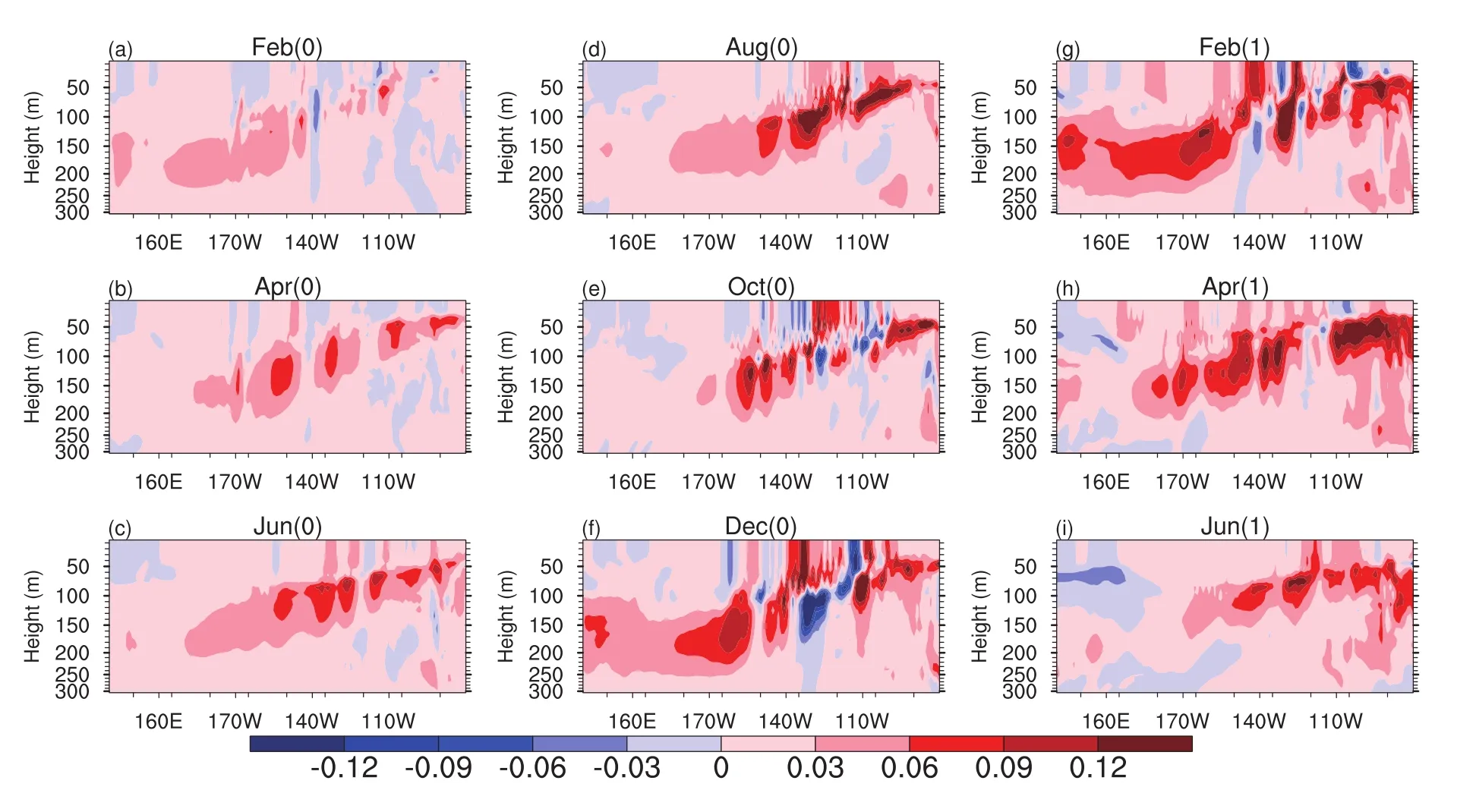
Fig.8.As in Fig.4,but for composite temperature anomalies from sensitivity experiments on negative observed IOD events.
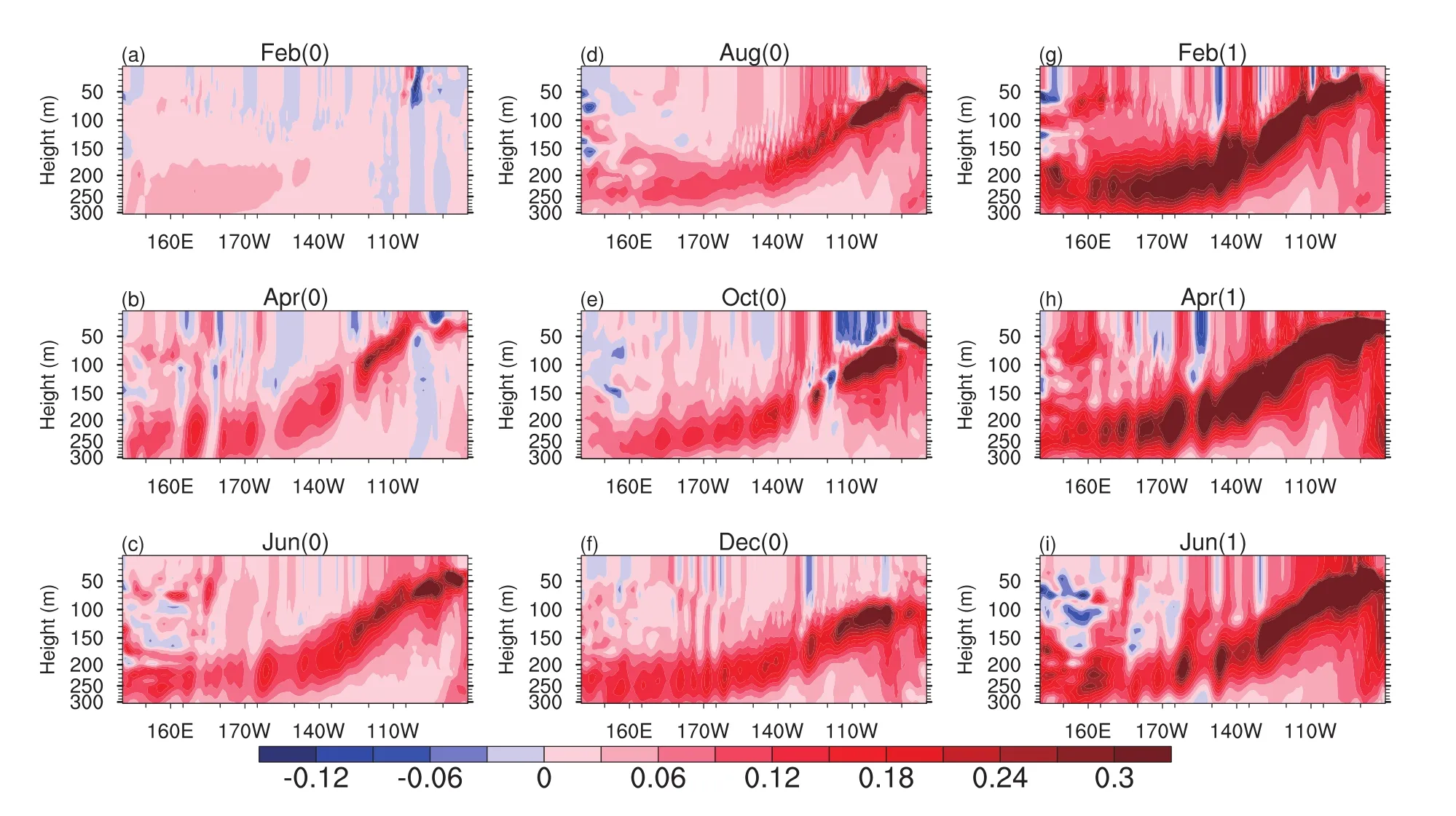
Fig.9.As in Fig.4,but for composite temperature anomalies from sensitivity experiments on 14 negative IOD events from the CESM 1.0.3 long-term run.
To address this question,we calculate the SSHAs in the Indian and Pacific oceans under the uncoupled configuration, and compare them w ith the SSH standard deviation under the coupled configuration to estimate the contribution of the IOD forcing to the ENSO-related Pacific variability.We fi rst calculate the SSH standard deviation in the Indian and Pacific oceans in terms of the CESM 1.0.3 output in the model years 0051 to 0150,and the observations(TOPEX/POSEIDON) during the period 1980–2008.Since IOD events often peak in boreal autumn and the SSH variability may have a much larger influence on the tropical Pacific Ocean via the ITF, we plot the SSH standard deviation in this season(exactly in November),derived from both CESM 1.0.3 and observations, in Figs.10a and b.The results indicate that the modelgoes some way toward representing the true situation,such that it can be used to estimate the contribution of the IOD forcing to the ENSO-related Pacific variability through the ITF.Meanwhile,since the SSHAs in the eastern Indian Ocean can indicate the propagation of Indian Ocean anomalies to the Pacific through the ITF(see section 4),and the SSHAs in the eastern Pacific Ocean are closely related to ENSO,we further calculate the SSH standard deviation in the eastern Indian Oceanand eastern Pacific Ocean(represented by regions A and B in Fig.10,where the SSHAsare shown to be largest)in November.Results for regions A and B also indicate that the model closely reproduces the observed situation.It is conceivable that,if only IOD forcing over the Indian Ocean is considered and the atmospheric forcing over the Pacific Ocean is the climatological state,then the change of the Pacific variability associated w ith ENSO may solely depend on the IOD forcing via the ITF.Therefore,SSHAs in region B under the uncoupled configuration and the SSH standard deviation under the coupled configuration can be compared to estimate the contribution of the IOD forcing to the Pacific variability associated w ith ENSO.

Fig.10.The SSH standard deviation(units:cm)in November from(a1)observations(TOPEX/POSEIDON)and(b1) the coupled model CESM 1.0.3.The ensemble mean of the SSHAs induced by the(c1)observed positive IOD forcing, and(d1)negative IOD forcing in sensitivity experiments.Panels(a2–d2)represent the averaged SSHA values(units: cm)over regions A and B.
Figures 10c1 and 10d1 plot the ensemble means of the SSHAsduring Nov(0)composited from all the observed positive and negative IOD forcings used in this study.For positive IOD forcing,during Nov(0),when positive IOD events peak,the ensemble mean of the SSHAs in region A is about -5.4 cm,which is roughly equal to the SSH standard deviation there;while in region B,the ensemble mean of the SSHAs is-0.61 cm.Quantitatively,positive IOD forcing in the Indian Ocean may explain about8%(0.61 cm divided by 7.27 cm)of the SSHAs in the eastern Pacific.For negative IOD forcing,itis shown in Figs.10d1 and 10d2 thatnegative IOD forcing can also explain about8%of the ElNi˜no-related SSHAs in the eastern Pacific through the ITF.
We notice that the sensitivity experiments shown in Figs. 10c and 10d tend to underestimate the SSHAs in the eastern Indian Ocean.Correspondingly,the SSHAs in the eastern Pacific m ightalso be underestimated.Despite this,the small SSHAs in the eastern Pacific induced by the IOD forcing in the Indian Ocean could also exhibit significant grow th due to the air–sea interaction in the tropical Pacific Ocean,and thereby greatly influence ENSO.
6.Summary and discussion
We use the oceanic model POP2,w ith observed and coupled-model-simulated external forcing from positive and negative IOD atmospheric data,to conductsensitivity experiments to exam ine the role of the ITF in the influence of the IOD on ENSO.
The results demonstrate that positive IOD events,both observed and modeled,can influence(via the ITF)the SSTAs associated w ith ENSO in the tropical eastern Pacific,inducing a La Ni˜na-like state in the Pacific Ocean the next year. Upwelling anomalies in the eastern Indian Ocean,indicated by negative SSHAs,can penetrate into the western Pacific Ocean through Indonesian sea passages.These SSHAs propagate furthereastward,inducing cooling in the eastern Pacific Ocean the follow ing year.These results are in accordance w ith those of the 1997 positive IOD eventobtained by Yuan etal.(2011).
We further investigate the role of the ITF in the influence ofnegative IOD on ENSO.We demonstrate thatnegative IOD events can also influence the Pacific Ocean in the follow ing year through the ITF.Physically,downwelling anomalies in the eastern Indian Ocean,reflected by positive SSHAsduring negative IOD events,propagate via the ITF into the western Pacific Ocean.These anomalies can further induce warm anomalies in the subsurface of the western Pacific and propagate eastward to the surface of the eastern Pacific.Ultimately, they result in an El Ni˜no-like SSTA state.Therefore,it is clear that the mechanism of the influence ofnegative IOD on the Pacific Ocean in the follow ing year is symmetrical to that of positive IOD.
We also estimate the contribution of IOD forcing to the ENSO-related Pacific variability.About8%of the eastern Pacific SSH variability associated w ith ENSO can be attributed to the IOD forcing in the tropical Indian Ocean through the ITF.However,this resultmay be dependenton the modelwe used.More sensitivity experiments carried outusing different models is recommended.
Finally,we note that the ITF is a complex passage involving three major channels:the Lombok Strait,the Ombai Strait,and the Timor Sea.The current level of know ledge aboutthese channels lim its ourunderstanding of the ITF transportation mechanism.In this study,we simply treat the ITF as a“black box”and do not consider how the upwelling and downwelling anomalies propagate from the Indian to the Pacific Ocean.
Acknow ledgements.The authors appreciate the anonymous reviewers very much for their valuable comments and suggestions.This work was sponsored by the National Public Benefi t (Meteorology)Research Foundation of China(Grant No.GYHY 201306018).
REFERENCES
A lexander,M.A.,I.Blade,M.Newman,J.R.Lanzante,N.C. Lau,and J.D.Scott,2002:The atmospheric bridge:The influence of ENSO teleconnections on air–sea interaction over the globaloceans.J.Climate,15,2205–2231.
Allan,R.J.,and Coauthors,2001:Is there an Indian Ocean dipole and is itindependentof the ElNi˜no-Southern Oscillation?InternationalCLIVAR Project Office,18–22.
Annamalai,H.,S.P.Xie,J.P.McCreary,and R.Murtugudde, 2005:Impactof Indian Ocean sea surface temperature on developing ElNi˜no.J.Climate,18,302–319.
Baquero-Bernal,A.,M.Latif,and S.Legutke,2002:On Dipolelike variability of sea surface temperature in the tropical Indian Ocean.J.Climate,15,1358–1368.
Behera,S.K.,J.J.Luo,S.Masson,S.A.Rao,H.Sakuma,and T. Yamagata,2006:A CGCM study on the interaction between IOD and ENSO.J.Climate,19,1688–1705.
Chen,D.,M.A.Cane,A.Kaplan,S.E.Zebiak,and D.Huang, 2004:Predictability of El Ni˜no over the past 148 years.Nature,428,733–736.
Clarke,A.J.,and S.Van Gorder,2003:Improving ElNi˜no prediction using a space-time integration of Indo-Pacific w inds and equatorial Pacific upper ocean heat content.Geophys.Res. Lett.,30,1399,doi:10.1029/2002GL016673.
Danabasoglu,G.,and Coauthors,2011:The CCSM 4 ocean component.J.Climate,25,1361–1389.
Deser,C.,and Coauthors,2012:ENSO and Pacific decadal variability in the community climate system model version 4.J. Climate,25,2622–2651.
Diaz,H.F.,M.P.Hoerling,and J.K.Eischeid,2001:ENSO variability,teleconnections and climate change.International Journal ofClimatology,21,1845–1862.
Hong,C.-C.,T.Li,and J.-J.Luo,2008a:Asymmetry of the Indian Ocean dipole.Part II:Model diagnosis.J.Climate,21, 4849–4858.
Hong,C.-C.,T.Li,L.Ho,and J.-S.Kug,2008b:Asymmetry of the Indian Ocean dipole.Part I:Observationalanalysis.J.Climate,21,4834–4848.
Izumo,T.,M.Lengaigne,J.Vialard,J.J.Luo,T.Yamagata,and G. Madec,2014:Influence of Indian Ocean Dipole and Pacific recharge on follow ing year’s El Ni˜no:Interdecadal robustness.Climate Dyn.,42,291–310.
Izumo,T.,and Coauthors,2010:Influence of the state of the Indian Ocean Dipole on the follow ing year’s El Ni˜no.Nature Geoscience,3,168–172.
Jin,E.,and Coauthors,2008:Current status of ENSO prediction skill in coupled ocean–atmosphere models.Climate Dyn.,31, 647–664.
Jochum,M.,B.Fox-Kemper,P.H.Molnar,and C.Shields, 2009:Differences in the Indonesian seaway in a coupled climate model and their relevance to Pliocene climate and El Ni˜no.Paleoceanography,24,PA1212,doi:10.1029/2008PA 001678.
Kug,J.S.,and I.S.Kang,2006:Interactive feedback between ENSO and the Indian Ocean.J.Climate,19,1784–1801.
Large,W.G.,and G.Danabasoglu,2006:Attribution and impacts ofupper-ocean biases in CCSM 3.J.Climate,19,2325–2346.
Latif,M.,and Coauthors,1998:A review of the predictability and prediction of ENSO.J.Geophys.Res.:-Oceans,103,14375–14393.
Lau,N.-C.,and M.J.Nath,2003:Atmosphere–Ocean Variations in the Indo-Pacific Sector during ENSO Episodes.J.Climate, 16,3–20.
Lee,T.,and Coauthors,2010: Consistency and fidelity of Indonesian-throughflow total volume transport estimated by 14 ocean data assimilation products.Dyn.Atmos.Oceans,50, 201–223.
Luo,J.-J.,S.Masson,S.K.Behera,and T.Yamagata,2008: Extended ENSO predictions using a fully coupled ocean–atmosphere model.J.Climate,21,84–93.
Luo,J.-J.,R.Zhang,S.K.Behera,Y.Masumoto,F.-F.Jin,R. Lukas,and T.Yamagata,2010:Interaction between El Ni˜no and Extreme Indian Ocean Dipole.J.Climate,23,726–742.
Meng,W.,and G.X.Wu,2000:Gearing between the Indian and Pacific Ocean(GIP)and the ENSO,Part2.modelsimulation. Chinese JournalofAtmospheric Sciences,24,15–25.(in Chinese)
Meyers,G.,R.J.Bailey,and A.P.Worby,1995:Geostrophic transport of Indonesian Throughflow.Deep-Sea Research Part IOceanographic Research Papers,42,1163–1174.
Nagura,M.,and M.Konda,2007:The seasonal developmentof an SST anomaly in the Indian Ocean and its relationship to ENSO.J.Climate,20,38–52.
Nicholls,N.,W.Drosdowsky,and A.M.S.Ams,2001:Is there an equatorial Indian Ocean SST dipole,independentof the El Ni˜no-Southern Oscillation?Climate Variability,the Oceans, and Societal Impacts,The The 81stAMS AnnualMeeting,Albuquerque,NM,U.S.,January 2001,17–18.
Roxy,M.,S.Gualdi,H.K.L.Drbohlav,and A.Navarra,2011: Seasonality in the relationship between El Ni˜no and Indian Ocean dipole.Climate Dyn.,37,221–236.
Saji,N.H.,and T.Yamagata,2003:Structure of SST and surface w ind variability during Indian Ocean dipole mode events: COADS observations.J.Climate,16,2735–2751.
Schott,F.A.,S.P.Xie,and J.P.M cCreary Jr.,2009:Indian ocean circulation and climate variability.Rev.Geophys.,47,doi: 10.1029/2007RG000245.
Shinoda,T.,W.Han,E.J.Metzger,and H.E.Hurlburt,2012:Seasonal Variation of the Indonesian Throughflow in Makassar Strait.J.Phys.Oceanogr.,42,1099–1123.
Tippett,M.K.,A.G.Barnston,and S.Li,2011:Performance of recent multimodel ENSO forecasts.J.Appl.Meteor.Climatol.,51,637–654.
Wang,B.,R.G.Wu,and X.H.Fu,2000:Pacific–East Asian teleconnection:How does ENSO affect East Asian climate?J. Climate,13,1517–1536.
Wu,G.,and W.Meng,1998:Gearing between the Indian and Pacific Ocean(GIP)and the ENSO,Part1.Data analyses.Chinese Journal of Atmospheric Sciences,22,470–480.(in Chinese)
Wyrtki,K.,1987:Indonesian through flow and the associated pressure gradient.J.Geophys.Res.:Oceans,92,12941–12946.
Yuan,D.L.,and Coauthors,2011:Forcing of the Indian Ocean Dipole on the interannual variations of the tropical Pacific Ocean:Roles of the Indonesian Throughflow.J.Climate,24, 3593–3608.
Yuan,D.L.,H.Zhou,and X.Zhao,2013:Interannual climate variability over the tropical Pacific Ocean induced by the Indian Ocean Dipole through the Indonesian Throughflow.J. Climate,26,2845–2861.
:Zhou,Q.,W.S.Duan,M.Mu,and R.Feng,2015:Influence of positive and negative Indian Ocean dipoles on ENSO via the Indonesian Throughflow:Results from sensitivity experiments.Adv.Atmos.Sci.,32(6),783–793,
10.1007/s00376-014-4141-0.
(Received 1 July 2014;revised 10 October 2014;accepted 15 November 2014)
∗Corresponding author:DUAN Wansuo Email:duanws@lasg.iap.ac.cn
©Institute of Atm ospheric Physics/Chinese Academ y of Sciences,and Science Press and Springer-Verlag Berlin Heidelberg 2015
 Advances in Atmospheric Sciences2015年6期
Advances in Atmospheric Sciences2015年6期
- Advances in Atmospheric Sciences的其它文章
- An Incursion of O ff-EquatorialSubsurface Cold Water and Its Role in Triggering the“Double Dip”La Ni˜na Event of 2011
- Analysis and Evaluation of the GlobalAerosolOpticalProperties Simulated by an Online Aerosol-coup led Non-hydrostatic Icosahedral Atmospheric M odel
- The Im pact of Surface Properties on Downward Surface Shortwave Radiation over the Tibetan Plateau
- Structures and Characteristics of the W indy Atmospheric Boundary Layer in the South China Sea Region during Cold Surges
- Asian Summer M onsoon Onset in Simulations and CM IP5 Projections Using Four Chinese Climate M odels
- A Diagnostic Analysis on the Effectof the Residual Layer in Convective Boundary Layer Development near M ongolia Using 20th Century Reanalysis Data
